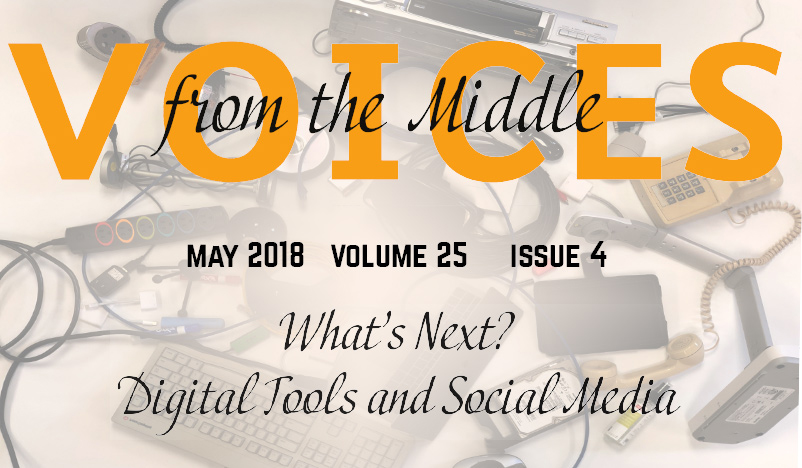This sneak peek is courtesy of “Office Hours” from the May 2018 issue of Voices from the Middle, by editors Sara Kajder, The University of Georgia, and Shelbie Witte, Oklahoma State University.
Next Practices with Digital Tools and Social Media
When we developed the idea of a “What’s Next?” series that would anchor the May issues of our editorship of Voices, we were intrigued with the idea that this call could serve as both a celebration of the newly emerging practices in our field and a view toward where we were headed. Our goal was both to excite and incite our pedagogical imaginations, especially as we bring one school year to a close and look eagerly to what the next one invites. The series started in Volume 24 with our exploration of “What’s Next in the Teaching of Reading.” You’re holding the second installment in your hands now—or, perhaps more aptly, you’re reading from your screen.
An issue that explores “What’s Next?” in our work with digital tools and social media sits right in that space between what we are coming to know and the certainty that our toolset and practices will continue to shift and change as they have in our teaching and our field for the past decade and a half. It is still new for us to be thinking about the ways in which digital tools and social media allow us to participate and collaborate in bold new ways, allowing our middle level students’ voices to do meaningful work within and beyond our classroom walls. It is also still new for us to think about the many authentic audiences that our students can access (and mobilize) with a keystroke. This issue is rich with articles that explore those spaces and keep reminding us of the possibility and necessity of this work.
NCTE has issued bold statements that help us see our responsibilities and role in this work as we read and write and learn alongside our students. With digital tools and social media, teaching English must invite students to create, communicate, and negotiate meaning in multimodal, connected, and participatory spaces. This isn’t about doing a “technology lesson.” Instead, it is work situated in building cultures in our classrooms where students turn to digital tools and social media alongside print-based work, choosing the spaces and media that best fit their message, audience, and intention.
That said, we can’t talk about this work without talking about access and without thinking critically about a digital divide that is as much about connecting kids to digital tools as it is connecting students and purposeful, mindful work with those tools. It shouldn’t be new or bold to say that every middle school student needs the opportunity to create, write, play, and critically evaluate digital texts—and yet it is. In too many contexts, we pull lower achieving students into computer-based programs for the purpose of remediation, limiting their time with digital tools to the keying in of responses to prepackaged curricula designed to boost test performance while providing those students who thrive in school with access to rich connective and multimodal digital reading and writing opportunities.
Instead of limiting digital experiences or seeing them as “enrichment,” we need to deem them essential and necessary for all students. In part, this comes if we stop thinking about teaching with technology and start thinking about students as creators of multimodal texts. But even that isn’t enough. It is no longer optional for students in our English classrooms to learn alongside us through opportunities where we engage them as critical, thoughtful, and reflective creators, consumers, and participants in connected communities. We need to be asking who gets to participate. And, we need to set our sights on what impact that participation by all learners can have.
More details on what’s in this issue of Voices from the Middle are available here.

